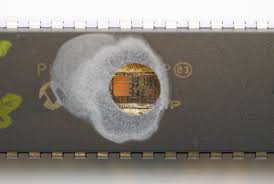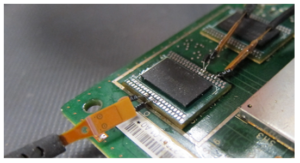Crack Microcontroller ATmega644PA Program
Crack Microcontroller ATmega644PA Program stands for the encrypted memory with flash and eeprom program or data copying out from original MCU;
The EEPROM Write Enable Signal – EEWE – is the write strobe to the EEPROM. When address and data are correctly set up, the EEWE bit must be set to write the value in to the EEPROM.
The EEMWE bit must be set when the logical “1” is written to EEWE, otherwise no EEPROM write takes place. The following procedure should be followed when writing the EEPROM (the order of steps 2 and 3 is not essential):
1. Wait until EEWE becomes zero.
2. Write new EEPROM address to EEAR (optional).
3. Write new EEPROM data to EEDR (optional).
4. Write a logical “1” to the EEMWE bit in EECR.
5. Within four clock cycles after setting EEMWE, write a logical “1” to EEWE.
Caution: An interrupt between step 4 and step 5 will make the write cycle fail, since the EEPROM Master Write Enable will time-out. If an interrupt routine accessing the EEPROM is interrupting another EEPROM access, the EEAR or EEDR register will be modified, causing the interrupted EEPROM access to fail.
It is recommended to have the global interrupt flag cleared during the four last steps to avoid these problems.
When the write access time (typically 5.1 ms if the internal RC oscillator is calibrated to 1.6 MHz) has elapsed, the EEWE bit is cleared (zero) by hardware. The user software can poll this bit and wait for a zero before writing the next byte.
When EEWE has been set, the CPU is halted for two cycles before the next instruction is executed.
· Bit 0 – EERE: EEPROM Read Enable
The EEPROM Read Enable Signal EERE is the read strobe to the EEPROM. When the correct address is set up in the EEAR register, the EERE bit must be set. When the EERE bit is cleared (zero) by hardware, requested data is found in the EEDR register.
The EEPROM read access takes one instruction and there is no need to poll the EERE bit. When EERE has been set, the CPU is halted for four cycles before the next instruction is executed in the process of MCU reading.
The user should poll the EEWE bit before starting the read operation. If a write operation is in progress when new data or address is written to the EEPROM I/O registers, the write operation will be interrupted and the result is undefined.
The calibrated oscillator is used to time EEPROM. In Table 16 the typical programming time is listed for EEPROM access from the CPU.
Tags: crack microcontroller locked archive,crack microcontroller locked code,crack microcontroller locked content,crack microcontroller locked data,crack microcontroller locked eeprom,crack microcontroller locked file,crack microcontroller locked firmware,crack microcontroller locked information,crack microcontroller locked memory,crack microcontroller locked program



